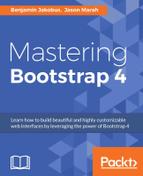Bootstrap is a free CSS and JavaScript framework that allows developers to rapidly build responsive web interfaces. The framework was first conceived by Mark Otto and Jacob Thornton while working at Twitter in 2010. Since its release as an open source project in August of 2011, Bootstrap has become a household name among frontend web developers. The framework’s ease-of-use along with its cross-browser compatibility, support for mobile user interfaces, and responsive web design capabilities, make it an essential building block for any modern web application. Totaling over 600 contributors, and more than 34,000 GitHub forks, Bootstrap has become the world’s most popular responsive web development framework. However, despite its popularity, there are relatively few advanced resources on the fourth, and latest, version of Bootstrap. As such, the motivation behind this book is to provide a comprehensive, step-by-step guide for developers that wish to build a complete, production-ready, website using Bootstrap 4. Once you turn the final pages of this book, you should be mastering the framework’s ins and outs, and building highly customizable and optimized web interfaces. You will know how to both extend the framework, integrate it with third-party components and frameworks, as well as optimize and automate your Bootstrapped builds.
Chapter 1, Revving Up Bootstrap, places the Bootstrap framework into context by highlighting the relevant features that come bundled with it. It briefly deals with various ways to include the framework and concludes by setting up the required files for the book’s demo project.
Chapter 2, Making a Style Statement, introduces the Bootstrap markup and style rules for the mobile-first grid system and HTML image elements. It also goes into the handy helper classes and responsive utilities that Bootstrap makes available to boost development speed.
Chapter 3, Building the Layout, focuses on starting to flesh out the demo project set up in Chapter 1, Revving Up Bootstrap, by adding a style guide for commonly used HTML elements and structuring the page layout.
Chapter 4, On Navigation, Footers, Alerts, and Content, shows you how to take advantage of Bootstrap to build footers and alerts, and how you can add and style various types of content using Bootstrap’s built-in classes.
Chapter 5, Speeding Up Development Using jQuery Plugins, focuses on how to use the handy third-party jQuery plugins to add interactivity and fun to a web page.
Chapter 6, Customizing Your Plugins, delves into the Bootstrap jQuery plugins’ code and customizes it to jazz up this book’s demo page. Plugins will be examined and extended throughout this chapter in an effort to not only make our page better, but to also improve our knowledge of how jQuery plugins are built and how they behave within Bootstrap’s ecosystem.
Chapter 7, Integrating Bootstrap with Third-Party Plugins, will identify new features or improvements that we want to make to our demo website. Consequently, the chapter will introduce libraries to help us achieve those goals, and figure out how these can be gracefully integrated with our existing architecture.
Chapter 8, Optimizing Your Website, shows how your website can be optimized for maximum performance and fast loading time on any device.
Chapter 9, Integrating with AngularJS and React, teaches the essentials of using Bootstrap within AngularJS and React. AngularJS is a Model-View-* JavaScript framework, while React is a JavaScript library that concentrates solely on the View part of the Model-View-Controller type stack. A vast amount of web pages are built with the frameworks or libraries such as AngularJS and React as they provide very useful abstractions on top of JavaScript and the DOM.
